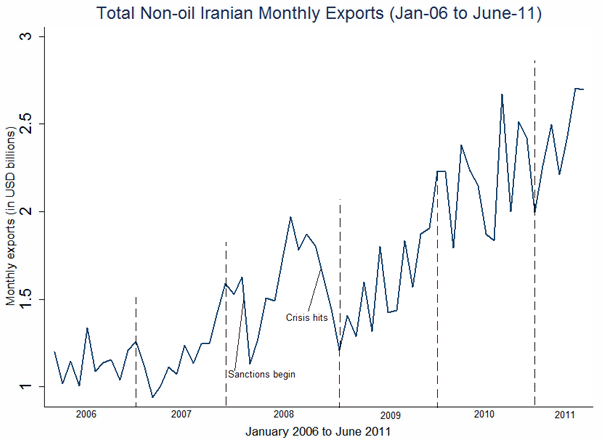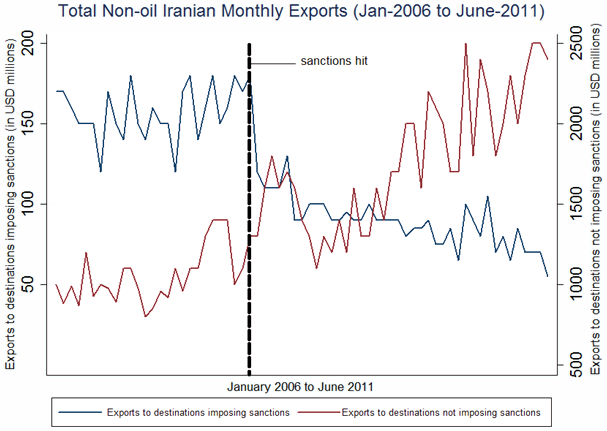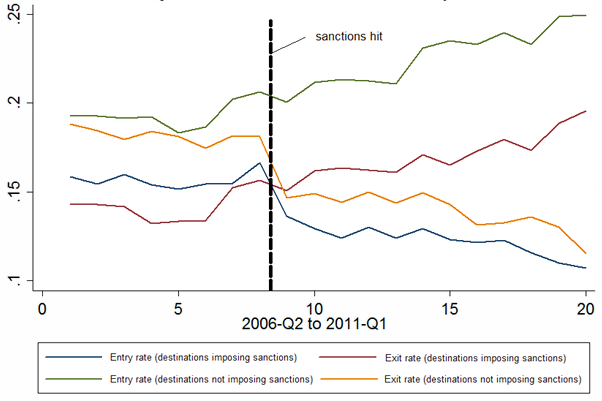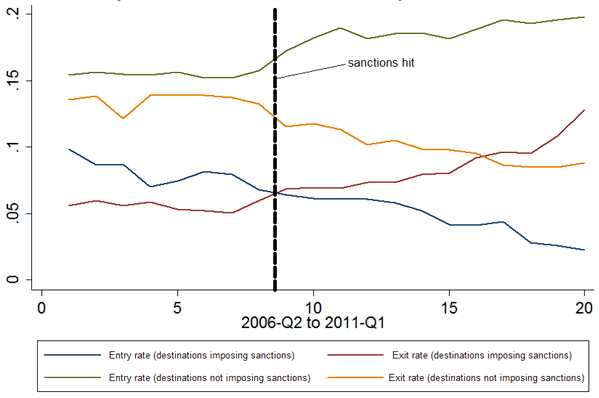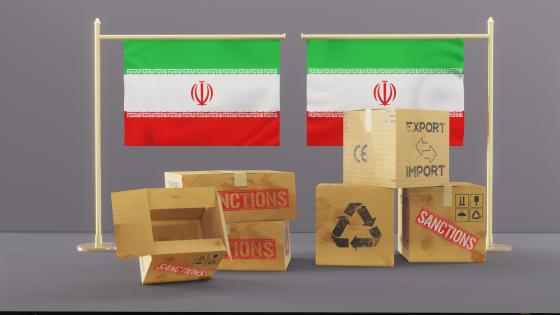Trade sanctions continue to be used by developed countries while attempting to change the behaviour of other governments. Sanctions still surface at the centre of current policy debates when it comes to Iran. Iran is no exception as, over the last century, sanctions were imposed 174 times by different countries (Hufbauer et al. 2007). However, we still lack an understanding about the impact and effectiveness of these trade sanctions. Due to an increasingly globalised economy, many alternative markets exist for an exporting country hit by sanctions. For example, following trade sanctions exporters may stop exporting, survive in the export market but with fewer products and exports, or divert to new markets. In recent research (Haidar 2013) I explore whether and how trade diversion happened following the trade sanctions against Iran in 2008.
Did sanctions on Iranian exporters divert exports?
To address this question, I obtained data from Iranian Customs.1 The disaggregated dataset includes all Iranian customs records at the exporter-product-destination-value-day level for the period January 2006 to June 2011. The sample includes 1,814,146 customs daily transactions, 35,953 exporters, and 3,865 products classified at the HS-6 digit level. These data allow me to measure the effect of sanctions on exporters' total sales at the destination level, and to observe whether exporters exited export markets or shifted to new destinations following sanctions. I find that the aggregate impact of sanctions on trade flows hides a rich set of microeconomic adjustments.
Figure 1 shows the evolution of non-oil exports between January 2006 and June 2011. The unexpected increasing trend following sanctions triggers the question whether Iranian non-oil exporters diverted their trade following sanctions and if sanctions actually caused trade diversion.
Figure 1. Iranian non-oil exports
Exports to destinations imposing sanctions decreased sharply following sanctions while exports to destinations not imposing sanctions increased significantly during the same period (Figure 2). Iranian exporters diverted their trade from the US and EU to Asian, African, and Latin American destinations.
Figure 2. Iranian non-oil exports: Sanction-imposing countries and other destinations
We observe similar trends at the micro level. Figures 3 and 4 look at the entry and exit rates of Iranian exporters and exported products across destinations. The entry and exit rates follow the same trends. While entry rates decreased in destinations imposing sanctions, they increased in destinations not imposing sanctions. Meanwhile, while exit rates increased in destinations imposing sanctions, they decreased in destinations not imposing sanctions.
Figure 3. Entry and exit rates of Iranian exporters
Figure 4. Entry and exit rates of Iranian exported products
In addition, the probability that any diverting exporter exits a destination imposing sanctions is 52% and that it subsequently enters a destination not imposing sanctions is 37%. Clearly, sanctions triggered Iranian exporters to divert trade to and establish new relationships in new markets.
How did trade diversion happen following sanctions?
Exporter-level data captures a lot of the action taking place within firms and across destinations. By tracking the universe of Iranian customs daily transactions, my research uncovers how Iranian trade diversion happened following sanctions and documents the extent of trade diversion that Iranian exporters were able to achieve. Precisely, I show how:
- Larger and more experienced exporters were able to divert relatively more of their exports than smaller and less experienced ones.
- The decision to divert products is not random. Exporters typically diverted first (and more of) their core-competence products as well as their homogeneous products compared to differentiated products.
- Exporters reduced their product prices while diverting trade to new destinations.
- The new destinations, which diverting exporters targeted, are larger and closer markets, destinations with higher imports, income, and FDI growth rates, as well as destinations with fewer import restrictions and lower tariff rates.
My findings add to the debate on sanctions and to the body of knowledge on exporter dynamics, multi-product firms, as well as trade creation, destruction, and diversion. While various authors argued that sanctions do not always achieve their goal, other studies suggest that sanctions often do succeed (i.e. Smeets 1990, Eaton and Engers 1992, Levy 1999, Eaton and Engers 1999, Evenett 2002, and Elliott et al. 2007). And, there is a burgeoning micro-econometric literature on the impact of macroeconomic and trade shocks on exporter dynamics (i.e. Iacovone and Javorcik 2010, Freund and Pierola 2010, Berman et al. 2012, Berthou and Fontagné forthcoming, and Khandelwal et al. forthcoming.2 However, to the best of our knowledge, no previous study has looked at the impact of sanctions on the behaviour of exporters.
Lessons to policymakers?
I provide evidence that sanctions may be less effective in a globalised world as traders can divert their trade from one trading partner to another. The idea that one country can impose trade sanctions on another may not necessarily prove effective unless the targeted country depends heavily on trading with the sanctioning country and its exporters do not have – or cannot – find compensating alternatives and new trading partners. Our empirical analysis can also provide potential support to recent theories that suggest that imposing sanctions can actually be no more effective than just threatening to impose sanctions. The evidence that we present calls for further theoretical and empirical investigations of the mechanisms by which sanctions achieve success or failure in the presence or absence of international consensus and cooperation.
The author would like to thank Jean Imbs for mentorship, continued guidance, support, and supervision.
References
Berman N, P Martin and T Mayer (2012), "How do different exporters react to exchange rate changes? theory and empirics", Quarterly Journal of Economics, 127(1): 437-492.
Berthou, A and L Fontagné (forthcoming), "How do Multiproduct Exporters React to a Change in Trade Costs", Scandinavian Journal of Economics.
Cebeci, T, A M Fernandes, C Freund, and M D Pierola, (2012), "Exporter dynamics database", Policy Research Working Paper Series 6229, The World Bank.
Eaton, J and M Engers (1999), "Sanctions: Some Simple Analytics", The American Economic Review, 89(2): 409-414.
Eaton, J and Engers, M. (1992), "Sanctions", Journal of Political Economy, 100(5): 899-928.
Evenett, S J (2002), "The Impact of Economic Sanctions on South African Exports", Scottish Journal of Political Economy, 49(5): 557-73.
Freund, C and M Pierola, (2010), "Export entrepreneurs: evidence from Peru", Policy Research Working Paper Series 5407, The World Bank.
Haidar, J I (2013), "Sanctions and Trade Diversion: Exporter-Level Evidence from Iran", Mimeo, Paris School of Economics
Hufbauer, G, K Elliott, B Oegg, and J Schott (2007), Economic Sanctions Reconsidered: 3rd Edition, Peterson Institute for International Economics.
Iacovone, L and B Javorcik (2010), "Multi-Product Exporters: Product Churning, Uncertainty and Export Discoveries" Economic Journal, 120(544): 481-499.
Khandelwal, A, P Schott and S-J Wei (forthcoming), "Trade Liberalization and Embedded Institutional Reform: Evidence from Chinese Exporters", The American Economic Review.
Levy, P I (1999), "Sanctions on South Africa: What Did They Do?" The American Economic Review, 89(2): 415–420.
Smeets, M (1990), "Economic Sanctions Against Iraq: The Ideal Case?" Journal of World Trade, 24(6): 105-20.
Van Bergeijk, P A G (2012), "Failure and success of economic sanctions", VoxEU.org, 27 March
1 I am grateful to Abbas Memarnejad and Hosein Mirjalili for making Iranian Customs data accessible for the purpose of this research project subject to complying with the confidentiality requirements set by Iranian Law.
2 Thanks to the recent World Bank Exporters Dynamics Database – Cebeci et al. (2012) – more studies on exporters dynamics are now feasible given data availability.
